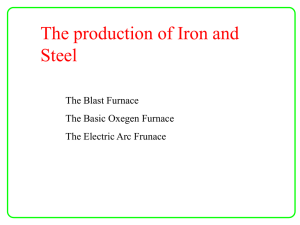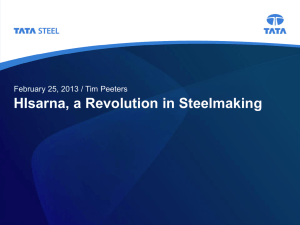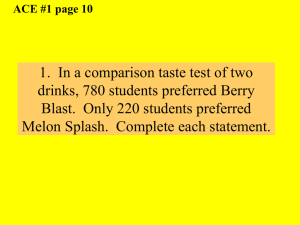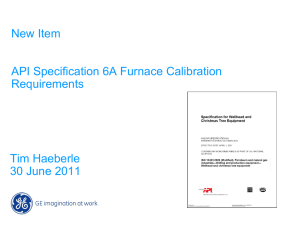lect-2-tpm-13-ironsteelmaking
advertisement
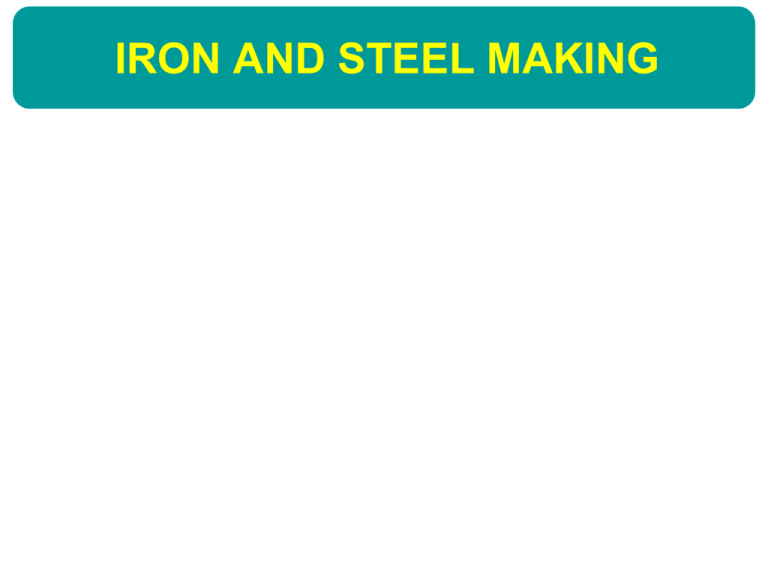
IRON AND STEEL MAKING IRON AND STEEL MAKING IRON AND STEEL MAKING Classified of Iron Ores By Minerals Iron ores are rocks and minerals most of whose deposites are found in sedimentary rocks. They formed from chemical reactions that combined iron and oxygen in marine and fresh waters. The ores are usually rich in iron oxides and vary in color from dark grey, bright yellow, deep purple, to rusty red. The most important minerals in these iron ore deposits are magnetite (Fe3O4), hematite (Fe2O3), goethite (FeO(OH)), limonite (FeO(OH).n(H2O)), ilmenite(FeTiO3) , siderite (FeCO3) and Pyrite (FeS2). These iron ores have been mined to produce almost every iron and steel object that we use today - from paper clips to automobiles to the steel beams in skyscrapers. Department of Materials and Metallurgical Engineering, FTI-ITS (4) Classified of Iron Ores By Minerals Mineralogical Characteristic of Iron Ores Department of Materials and Metallurgical Engineering, FTI-ITS (5) Classified of Iron Ores By Harmful Impurities By harmful impurities (S, P, Cu, Pb, Zn, V, Ti, Co, Ni, Sn, F, As) ratio of content, iron ores can be divided into high-sulfur iron ore, low sulfur iron ore, high phosphorus iron Ore, low phosphorus iron ore and so on. Harmful impurities are often the minerals that we remove from iron ore in the ore production. Sometimes for removing these impurities , some special physical or chemical methods of beneficiation are chosen to filter them. Department of Materials and Metallurgical Engineering, FTI-ITS (6) Classified of Iron Ores Department of Materials and Metallurgical Engineering, FTI-ITS (7) Function of Coke in Blast Furnace For blast furnace ironmaking the most important functions of coke are: – To provide the structure through which gas can ascend and be distributed through the burden. Coke is a solid and permeable material up to very high temperatures (> 2000 °C), which is of particular importance in the hearth and melting and softening zone. Below the melting zone coke is the only solid material, so the total weight of the blast furnace content is supported by the coke structure. The coke bed has to be permeable, so that slag and iron can flow downward to accumulate in the hearth and flow to the tap hole. – To generate heat to melt the burden – To generate reducing gases – To provide the carbon for carburization of the hot metal – To act as a filter for soot and dust. Department of Materials and Metallurgical Engineering, FTI-ITS (8) Function of Coke in Blast Furnace Department of Materials and Metallurgical Engineering, FTI-ITS (9) Coke in Blast Furnace Coke is the most important raw material fed into the blast furnace in terms of its effect on blast furnace operation and hot metal quality. A high quality coke should be able to support a smooth descent of the blast furnace burden with as little degradation as possible while providing the lowest amount of impurities, highest thermal energy, highest metal reduction, and optimum permeability for the flow of gaseous and molten products. Introduction of high quality coke to a blast furnace will result in lower coke rate, higher productivity and lower hot metal cost. Department of Materials and Metallurgical Engineering, FTI-ITS (10) Coal Blends for Coke making The coal selected to make coke is the most important variable that controls the coke properties. The rank and type of coal selected impacts on coke strength while coal chemistry largely determines coke chemistry. In general, bituminous coals are selected for blending to make blast furnace coke of high strength with acceptable reactivity and at competitive cost. For the conventional recovery coking process the blend must contract sufficiently for easy removal from the oven and pressure must be acceptable. For the heat–recovery process type these constraints are not valid, which leads to an increase of usable coal types in this type of process. Table shows the typical chemical composition of coke that may be considered to be of good quality. Department of Materials and Metallurgical Engineering, FTI-ITS (11) IRONMAKING Coke ovens Pro- duct Lump Coke 1,227,000 Ton (63.5%) To Blast Furnace Coke Total (74.0%) Coal COKE Coke Breeze To Sinter plant 203,000 Ton(10.5%) OVEN 1,932,000 Ton/Year Chemicals 1200 – 1300C COG 618 Mil. N㎥(21.2%) To Power plant BTX 23,000 Ton(1.0%) To Processing plant Tar 81,000 Ton(3.0%) For Sale Others (0.8%) For Sale Blast Furnace Blast Furnace Blast Furnace The quenched blast furnace shows clearly the layer structure of coke and ore. Further analysis reveals information about the heating and melting of the ore as well of the progress of chemical reactions. As indicated in Figure 1.3, at any moment, an operating blast furnace contains, from top downwards: : – Layers of ore and coke. – An area where ore starts to soften and melt, known as the softening–melting zone. – An area where there is only coke and liquid iron and slag, called the “activecoke” or dripping zone. – The dead man, which is a stable pile of coke in the hearth of the furnace. A blast furnace has a typical conical shape. The sections from top down are: – Throat, where the burden surface is. – The stack, where the ores are heated and reduction starts. – The bosh parallel or belly and – The bosh, where the reduction is completed and the ores are melted down. – The hearth, where the molten material is collected and is cast via the taphole. Blast Furnace – A blast furnace is filled with alternating layers of coke and the iron ore–containing burden. – Hot blast is blown into the blast furnace via tuyeres. A tuyere is a cooled copper conical pipe numbering up to 12 in smaller furnaces, and up to 42 in bigger furnaces through which pre–heated air (up to more than 1200 °C) is blown into the furnace. – The hot blast gasifies the reductant components in the furnace, those being coke as well as auxiliary materials injected via the tuyeres. In this process, the oxygen in the blast is transformed into gaseous carbon monoxide. The resulting gas has a high flame temperature of between 2100 and 2300 °C . Coke in front of the tuyeres is consumed thus creating voidage The driving forces in the blast furnace are illustrated in Figure 1.5. – The very hot gas ascends through the furnace , carrying out a number of vital functions. – Heats up the coke in the bosh/belly area. Blast Furnace Blast Furnace Blast Furnace – Melting the iron ore in the burden, creating voidage. – Heats up the material in the shaft zone of the furnace. – Removes oxygen of the ore burden by chemical reactions. – Upon melting, the iron ore produces hot metal and slag, which drips down through the coke zone to the hearth, from which it is removed by casting through the taphole. In the dripping zone the hot metal and slag consume coke, creating voidage. Additional coke is consumed for final reduction of iron oxide and carbon dissolves in the hot metal, which is called carburisation. The blast furnace can be considered as a counter current heat and mass exchanger, as heat is transferred from the gas to the burden and oxygen from the burden to the gas. Gas ascends up the furnace while burden and coke descend down through the furnace. The counter current nature of the reactions makes the overall process an extremely efficient one. Blast Furnace A typical example of the temperature profile in the blast furnace is shown in Figure 1.6. It is shown that the softening/melting zone is located in an area where temperatures are between 1100 and 1450 °C. The temperature differences in the furnace are large. Blast Furnace Blast Furnace Equipment overview An overview of the major equipment is shown in Figure 1.7. These include: – Hot Blast Stoves. Air preheated to temperatures between 1000 and 1250 °C is produced in the hot blast stoves and is delivered to the furnace via a hot blast main, bustle pipe, tuyere stocks and finally through the tuyeres. The hot blast reacts with coke and injectants. The high gas speed forms the area known as the raceway in front of the tuyeres. – Stock house. The burden materials and coke are delivered to a stock house. The materials are screened and then weighted before final delivery into the furnace. The stock house is operated automatically. Corrections for coke moisture are generally made automatically. The burden materials and coke are brought to the top of the furnace via skips or via a conveyor belt, where they are discharged into the furnace in separate layers of ore and coke. – Gas cleaning. The top gas leaves the furnace via uptakes and a down–comer. The top gas will contain many fine particles and so to remove as many of these as possible the top gas is lead through a dust catcher and wet cleaning system. Blast Furnace – Casthouse. The liquid iron and slag collect in the hearth of the furnace, from where they are tapped via the taphole into the casthouse and to transport ladles. – Slag granulation. The slag may be quenched with water to form granulated slag, which is used for cement manufacturing. The top of the blast furnace is closed, as modern blast furnaces tend to operate with high top pressure. There are two different systems: – The double bell system, often equipped with a movable throat armour. – The bell less top, which allows easier burden distribution. Examples of both types are schematically shown in Figure 1.8.
